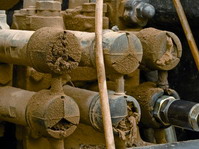 A free, informative guide is now available, which outlines the facts, risks and steps required by Industrial companies to help prevent dust explosions in their plants. The guide is particu-larly useful to owners, engineers and senior managers, who are responsible for health and safety and who source electrical equipment for hazardous areas within the plant.
A free, informative guide is now available, which outlines the facts, risks and steps required by Industrial companies to help prevent dust explosions in their plants. The guide is particu-larly useful to owners, engineers and senior managers, who are responsible for health and safety and who source electrical equipment for hazardous areas within the plant.
The eight-page guide, published by explosion protection electrical equipment specialist Cooper Crouse-Hinds, provides an introduction to the subject of dust explosions, including why and when they can occur; the latest European dust standards; safety measures; who is responsible for equipment safety; dust explosion facts and statistics; and ignition data on a wide variety of dust types, including food dusts, metals and chemicals.
Graham Doran, Sales and Marketing Director at Cooper Crouse-Hinds (UK) Ltd comments: “Around 2,000 dust explosions occur in the EU each year, which is staggering. Companies affected by potential dust explosions include manufacturers of sugar, coal, cocoa, flour-based products, milk powder, tea, grain, fodder and tobacco, as well as wood and metal processing companies. When it comes to sourcing electrical equipment for areas where there is a risk of dust explosions, many companies in these sectors are not fully aware of the latest relevant European Standards.”
In particular, from December 2006, the new standard EN 61241-0 was introduced, which together with EN 61241-14 obliges the owner of a plant to use products that conform to these strict standards. Changes in the latest standards relate especially to impact strength of housings; electrostatic discharge capability of the housings; and ageing resistance of the plastics used.
Doran continues: “A dust explosion requires only three things: air, combustible dust and a source of ignition. This means many companies and equipment are affected. Mixers, filling hoppers, conveyor systems, mills, silos, dust extraction plant, kilns and drying systems are all affected here. Also, if combustible dusts are left to gather on hot surfaces, such as an over-heated electric motor, smouldering fires can occur. These can cause an explosion when the dust is kicked up, for example, if somebody opens a nearby window. This type of explo-sion can be very dangerous because the initial shock wave resulting from the explosion kicks up more dust, which triggers a kind of chain reaction through the plant, often resulting in mass destruction of equipment and buildings, as well as being a risk to human life. With the introduction of the Corporate Manslaughter Act in 2007, this is a particularly worrying time for UK-based companies.”
Cooper Crouse-Hinds provides a comprehensive range of explosion-protected electrical equipment, including fluorescent light fittings, emergency lighting, switches, terminal boxes, control stations, portable lamps, connectors and plugs.
For your free copy of the guide, or for a copy of the new full range dust catalogue entitled “Catalogue Dust-Ex 712: dust explosion-protected luminaries and apparatus”, please con-tact Cooper Crouse-Hinds’ UK sales office on 02476 308930 or email This email address is being protected from spambots. You need JavaScript enabled to view it.

